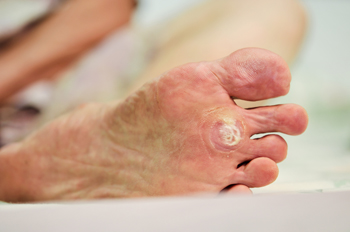 Persistent cracked heels, medically known as heel fissures, can move from a mere cosmetic concern to a painful and potentially serious condition if left untreated. Medical treatment is important for cracked heels that persist for more than a week. A podiatrist, or foot doctor, can remove dead skin to reduce the risk of infection and allow for deeper penetration of therapeutic agents. Podiatrists may also prescribe special creams containing urea or salicylic acid, which are more potent than over-the-counter lotions and designed to hydrate and promote healing in the deeper layers of the skin. In cases where structural issues of the foot contribute to the problem, custom orthotics may be prescribed to redistribute pressure away from the heels. Other possible treatments include bandaging the affected area or using tissue glue to mobilize cracks. If you’re suffering from cracked heels, it is suggested that you make an appointment with a podiatrist to find relief and prevent any complications.
Persistent cracked heels, medically known as heel fissures, can move from a mere cosmetic concern to a painful and potentially serious condition if left untreated. Medical treatment is important for cracked heels that persist for more than a week. A podiatrist, or foot doctor, can remove dead skin to reduce the risk of infection and allow for deeper penetration of therapeutic agents. Podiatrists may also prescribe special creams containing urea or salicylic acid, which are more potent than over-the-counter lotions and designed to hydrate and promote healing in the deeper layers of the skin. In cases where structural issues of the foot contribute to the problem, custom orthotics may be prescribed to redistribute pressure away from the heels. Other possible treatments include bandaging the affected area or using tissue glue to mobilize cracks. If you’re suffering from cracked heels, it is suggested that you make an appointment with a podiatrist to find relief and prevent any complications.
Cracked heels are unsightly and can cause further damage to your shoes and feet. If you have any concerns, contact Scott Samera, DPM from Samera / Foot + Ankle. Our doctor can provide the care you need to keep you pain-free and on your feet.
Cracked Heels
Cracked heels appear unappealing and can make it harder for you walk around in sandals. Aside from looking unpleasant, cracked heels can also tear stockings, socks, and wear out your shoes. There are several methods to help restore a cracked heel and prevent further damage.
How Do You Get Them?
Dry skin is the number one culprit in creating cracked heels. Many athletes, walkers, joggers, and even swimmers suffer from cracked heels. Age and skin oil production play a role to getting cracked heels as well.
Promote Healing
Over the counter medicines can help, especially for those that need instant relief or who suffer from chronic dry feet.
Wear Socks – Wearing socks with medicated creams helps lock in moisture.
Moisturizers – Applying both day and night will help alleviate dryness which causes cracking.
Pumice Stones – These exfoliate and remove dead skin, which allows for smoother moisturizer application and better absorption into the skin.
Change in Diet
Eating healthy with a well-balanced diet will give the skin a fresh and radiant look. Your body responds to the kinds of food you ingest. Omega-3 fatty acids and zinc supplements can also revitalize skin tissue.
Most importantly, seek professional help if unsure how to proceed in treating cracked heels. A podiatrist will help you with any questions or information needed.
If you have any questions, please feel free to contact our office located in Lake City and Branford, FL . We offer the newest diagnostic and treatment technologies for all your foot care needs.













